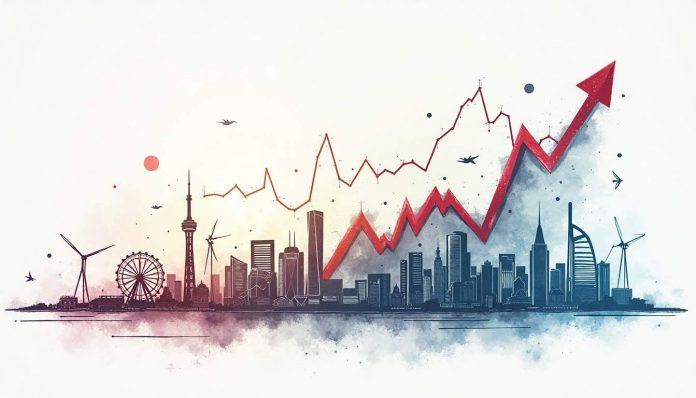Introduction to Economic Trends
The global economy is currently navigating a complex landscape characterized by heightened uncertainty and evolving geopolitical dynamics. As we look towards 2025, understanding these trends, particularly through an economic analysis lens, is crucial for investors, policymakers, and businesses alike. This analysis aims to shed light on key economic indicators, potential risks, and the implications for various sectors.
One of the most significant trends shaping the economic landscape is the shift towards sustainability and green technologies. With increasing awareness of climate change and its impacts, governments and corporations are prioritizing investments in renewable energy, sustainable agriculture, and eco-friendly practices. This transition not only presents opportunities for innovation and job creation but also poses challenges for industries reliant on traditional energy sources. As regulatory frameworks evolve, companies must adapt to remain competitive, making sustainability a central theme in strategic planning.
Moreover, the rise of digital currencies and fintech solutions is transforming the financial sector. Central banks around the world are exploring the potential of Central Bank Digital Currencies (CBDCs), which could revolutionize payment systems and enhance financial inclusion. Meanwhile, the proliferation of blockchain technology is fostering new business models and enhancing transparency across various industries. As these developments unfold, stakeholders must consider the implications for monetary policy, regulatory environments, and consumer behavior, as the intersection of technology and finance continues to redefine economic interactions.
Understanding Economic Uncertainty
Economic uncertainty remains a significant theme as we move into 2025. An index of global economic uncertainty, weighted by GDP, reveals that levels have stayed elevated despite some de-escalation in tariff conflicts. This persistent uncertainty can have profound implications for investment strategies and consumer behavior. Factors such as fluctuating commodity prices, shifting labor markets, and changing consumer preferences further contribute to this climate of unpredictability, making it imperative for businesses and individuals alike to stay informed and adaptable.

Investment Decisions Under Pressure
With elevated uncertainty, investment and big-ticket consumption decisions are likely to be negatively impacted in the near term. Investors are more cautious, requiring a risk premium in the market to compensate for potential volatility. As a result, sectors that rely heavily on consumer spending may experience slower growth, impacting overall economic momentum. Moreover, the hesitance to invest can lead to a slowdown in innovation and expansion, as companies may opt to preserve cash rather than allocate funds toward new projects. This trend could create a feedback loop, where reduced investment leads to slower economic recovery, further entrenching the uncertainty that businesses face.
Geopolitical Risks and Their Implications
Geopolitical risks, particularly those related to trade, are intricately linked to economic uncertainty. The ongoing tariff negotiations between the United States and China exemplify this complexity. While tariff risks are a concern, the broader implications of U.S. withdrawal from global markets pose a more profound and long-term risk to asset prices. Investors must remain vigilant to navigate these turbulent waters. Additionally, the rise of protectionist policies in various countries can lead to fragmented supply chains, increasing costs for businesses and potentially leading to inflationary pressures. The interplay of these geopolitical dynamics not only shapes market sentiment but also influences strategic decisions made by multinational corporations, as they weigh the risks of operating in an increasingly volatile global landscape.
Valuation Trends in Equity Markets
Equity market valuations are a critical area of focus as we approach 2025. Current valuations appear rich when viewed both on a standalone basis and in comparison to treasury yields. This valuation compression, coupled with economic uncertainty, contributes to a bearish stance in the near term. Investors are increasingly cautious, weighing the potential for interest rate hikes against the backdrop of a slowing economy. The interplay between inflation rates and consumer spending is also pivotal, as these factors can significantly influence market dynamics and investor confidence.

Comparative Analysis with Previous Drawdowns
The recent market drawdown mirrors the inflation spike episode of 2021-2022. However, it is essential to note that the current market movements reflect valuation compression rather than a direct impact on earnings. As such, the potential for further declines in equity prices remains a concern, particularly if earnings do not meet investor expectations. Historical data suggests that prolonged periods of high valuations often precede corrections, and investors are advised to remain vigilant. Analysts are closely monitoring key indicators such as P/E ratios and forward earnings projections to gauge the sustainability of current valuations in light of macroeconomic trends.
Tariffs and Their Economic Impact
The fluctuating nature of tariffs has a direct impact on inflation and corporate margins. Even with recent discussions around tariffs, the effective tariff rate for the U.S. stands at approximately 20%, a stark increase from the less than 5% rate observed over the past decade. This significant shift raises concerns about material impacts on inflation and corporate profitability, which could further dampen market sentiment. Additionally, the ripple effects of these tariffs extend beyond domestic borders, affecting global supply chains and trade relationships. Companies that rely heavily on imported goods may face increased costs, which could ultimately be passed on to consumers, further exacerbating inflationary pressures. As businesses navigate this complex landscape, strategic adjustments in pricing and sourcing will be crucial for maintaining competitive advantage.
The Role of U.S. Exceptionalism
As global investors reassess the concept of U.S. exceptionalism, the implications for currency, treasury, and stock markets become increasingly pronounced. The fading belief in U.S. exceptionalism is evident as long-term international investors emerge as marginal sellers in these markets. This shift not only reflects a changing global economic landscape but also highlights the growing confidence in emerging markets, which are often seen as more dynamic and potentially lucrative alternatives.
Potential Risks in the Treasury Market
The shift in investor sentiment raises the risk of higher yields in the treasury market. As the demand for U.S. treasuries wanes, the potential for rising yields could create challenges for both domestic and international investors. This dynamic may lead to a weaker dollar, further complicating the economic landscape. Moreover, if the yields on U.S. treasuries rise significantly, it could prompt a reevaluation of risk across various asset classes, as investors may begin to demand higher returns on equities and corporate bonds to compensate for the increased risk associated with a declining dollar.
Implications for the Stock Market
In the stock market, the implications of fading U.S. exceptionalism are multifaceted. Investors may seek alternative markets or asset classes, leading to increased volatility in U.S. equities. As the market adjusts to these changes, sectors that have traditionally benefited from U.S. leadership may face headwinds. For instance, technology and healthcare stocks, which have thrived under the banner of American innovation, could see diminished investor confidence if they are perceived as vulnerable to global competition. Furthermore, the potential shift in capital flows could lead to a reallocation of resources, with investors favoring companies that are more globally diversified or those that operate in countries with more favorable economic outlooks.
Additionally, the erosion of U.S. exceptionalism may prompt a reassessment of corporate governance and regulatory frameworks within the U.S. market. Investors might start to prioritize firms that demonstrate resilience in the face of global challenges, such as climate change or geopolitical tensions. This could lead to a greater emphasis on Environmental, Social, and Governance (ESG) criteria, as stakeholders increasingly demand accountability and sustainability from the companies they invest in. As these trends unfold, the landscape of the U.S. stock market may undergo significant transformations, reflecting a broader shift in investor priorities and expectations.
Inflation Volatility: A Growing Concern
Inflation volatility is another critical factor that could shape the economic landscape in 2025. The interplay between fragile supply chains and potential trade diversions, such as near-shoring or friend-shoring, has the potential to create short-term price spikes. These shifts in supply chain strategies are not merely reactive but are often driven by a desire to enhance resilience against future disruptions. As companies reassess their sourcing strategies, they may also invest in technology and automation to streamline operations, which could lead to longer-term benefits even amidst short-term challenges.
Short-Term Price Spikes and Market Reactions
As companies adapt to changing supply chain dynamics, they may encounter unexpected price fluctuations. This volatility can complicate forecasting and budgeting processes, making it challenging for businesses to maintain stable pricing. Moreover, consumer behavior can shift dramatically in response to these price changes, leading to a ripple effect across various sectors. For instance, if essential goods experience a sudden price hike, consumers may pivot to alternative products, further complicating market dynamics. Investors should be aware of these potential disruptions and consider strategies to mitigate risks associated with inflation. Understanding consumer sentiment and market trends will be crucial for businesses aiming to navigate this unpredictable environment.
Hedging Against Inflation Volatility
Finding direct hedges against inflation volatility can be tricky. Traditional methods may not suffice in a landscape characterized by frequent price fluctuations. Investors may need to explore alternative strategies, such as rate volatility products, to navigate this uncertain terrain effectively. Additionally, diversifying investment portfolios to include commodities or inflation-linked bonds could provide a buffer against inflationary pressures. As the economic landscape evolves, staying informed about emerging financial instruments and hedging techniques will be essential for both individual and institutional investors. The key will be to remain agile and responsive to the rapidly changing economic indicators, ensuring that strategies are aligned with current market realities.
Conclusion: Preparing for the Future
As the global economy approaches 2025, understanding the key trends and insights is essential for navigating the complexities ahead. Economic analysis, uncertainty, valuation trends, geopolitical risks, and inflation volatility all play a role in shaping the future landscape.

Investors, policymakers, and businesses must remain agile and informed to adapt to these changes. By recognizing the interconnectedness of these factors, stakeholders can better prepare for the challenges and opportunities that lie ahead. The road to 2025 may be fraught with uncertainty, but with careful economic analysis and strategic planning, it is possible to navigate the complexities of the evolving economic environment.
Stay Ahead with Market Digests
As we journey towards 2025 amidst the evolving economic landscape, staying informed is more crucial than ever. Market Digests is dedicated to providing you with the comprehensive market insights and analysis you need to face the future with confidence. Don’t miss out on the latest trends and strategic advice that could shape your investment decisions. Subscribe for Updates today and take the first step towards mastering the complexities of the stock market.

